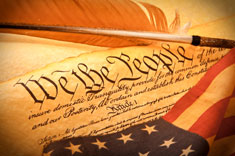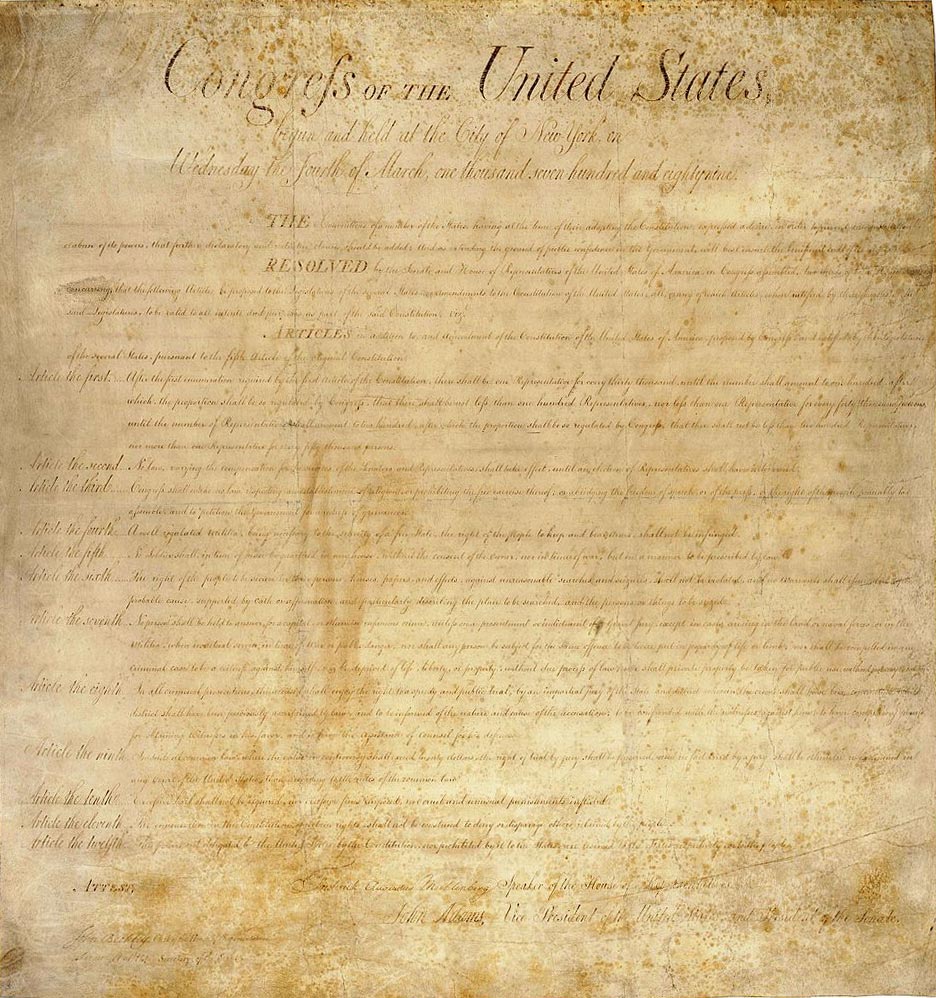| United States Constitution | |
|---|---|
 |
|
| The U.S. Constitution | |
| Preamble | |
| Articles of the Constitution | |
| I ‣ II ‣ III ‣ IV ‣ V ‣ VI ‣ VII | |
| Amendments to the Constitution | |
| Bill of Rights | |
| I ‣ II ‣ III ‣ IV ‣ V ‣ VI ‣ VII ‣ VIII ‣ IX ‣ X | |
| Additional Amendments | |
| XI ‣ XII ‣ XIII ‣ XIV ‣ XV ‣ XVI ‣ XVII ‣ XVIII ‣ XIX ‣ XX ‣ XXI ‣ XXII ‣ XXIII ‣ XXIV ‣ XXV ‣ XXVI ‣ XXVII | |
| View the Full Text | |
| Original Constitution | |
| Bill of Rights | |
| Additional Amendments |
The Tenth Amendment is a promise of State’s rights which was ratified on December 15, 1791. It reiterates that the Federal government has the powers itemized to it by Article 1, section 8 of the constitution. The amendment reinforces the idea of federalism by stating that unless the constitution grants powers to the federal government within the detailed powers, then the power is reserved to the people or the states. The federal government has continued to take more power from the states over the years, as the Supreme Court and the Congress have given it wider powers following other amendments, like the 14th Amendment.
Text
The powers not delegated to the United States by the Constitution, nor prohibited by it to the States, are reserved to the States respectively, or to the people.
10th Amendment Explained
Originally, the Bill of Rights did not apply to the States when the 10th Amendment was being proposed for the first time; instead it just applied to the Federal law. All states had their own bill of rights and constitutions. Slavery was legal in some states and was protected under the 10th Amendment. During the Civil War it became clear that this system was not workable and therefore the 14th Amendment extended the Bill of Rights making it applicable to the federal law and the states. Due to that fact, the 10th amendment does not hold much power as it once did, although it still remains relevant.
Purpose
 The main reason why the founding fathers put this amendment into the bill of rights is that, they wanted a central government that could not become very powerful. They wanted more power to be retained in their local state legislatures, rather than a government that was located away from their homes dictating how they should live their lives.
The main reason why the founding fathers put this amendment into the bill of rights is that, they wanted a central government that could not become very powerful. They wanted more power to be retained in their local state legislatures, rather than a government that was located away from their homes dictating how they should live their lives.
History
During the Revolutionary War, on July 2, 1776, the thirteen colonies declared their independence from Britain all at once. This is the day that the declaration was voted upon and passed however; the decision was announced to the public on July 4 for the first time.
Immediately after the declaration, the 13 colonies became individual sovereign countries or states with their own government. However, they would still come together sometime in their war against Britain. When Richard Lee proposed the Declaration of Independence to the congress on June 6, 1776; he also proposed a confederation plan to be prepared and sent to the colonies for consideration.
A committee was set up and looked into how the colonies would come together. Afterwards, it sent its proposal to the Congress in mid-1777. The Congress discussed the plan and adopted it formally on November 1777. The plan was called Articles of Confederation. Each sovereign state had to decide whether it wanted to be involved in the new union. It took several years until the articles were ratified by all the 13 colonies. This is because they did not want a dictatorial government. It is for that same reason that the founding fathers included the 10th Amendment text in Article 2 of the Articles of Confederation, with the aim of preventing Federal government from exercising powers not granted to it.
The founding fathers wanted the central government to have limited powers. With the Articles of Confederation in place, the government became less powerful, to the point that it could barely function. After some time, the government was dissolved and the founding fathers created a Constitution of the U.S. Nevertheless, the Constitution still implicated limited powers to the Federal government, and the power was enough to sustain the government.Presently the U.S. government still operates according to the Constitution.
Ratification of the Constitution
The States had to ratify the constitution for it to become law after it was written in 1789. The States’ rights issue recurred, since most people were concerned that the Constitution had taken much power from the states. The Federalists wanted a stronger government with enough power to function properly, unlike the government that was running under the Articles of Confederation. The Anti-Federalists on the other hand, wanted a limited central government, with the States having more power.
The Compromise
With the ratification of the constitution falling into jeopardy, the Federalists finally came up with the Massachusetts Compromise. This compromise managed to persuade enough Anti-Federalists to vote yes for the Constitution. When the new government started to operate, James Madison proposed a list of 20 amendments, carefully chosen from a list submitted by the states for amendment.
On September 25 1789, the congress voted yes to accept 12 of the 20 amendments and then passed them to the states. Ten out of the 12 amendments became law on December 15, 1791 after the Virginia’s vote for ratification. The 10th Amendment was the last of the 10, and the amendments are still known as Bill of Rights up to date.